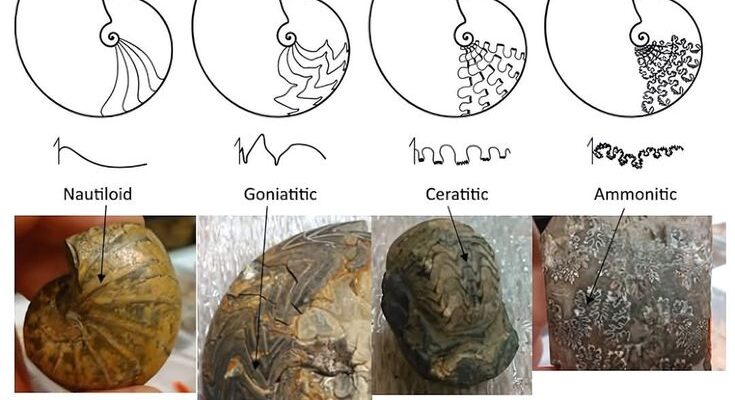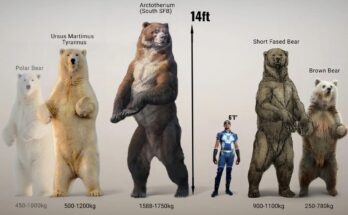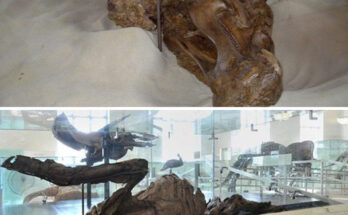Index Fossils: Ammonites – A Journey Through Geological Time
Ammonites, the iconic spiral-shelled marine mollusks, are among the most valuable tools in paleontology for dating and understanding Earth’s geological history. This detailed guide, inspired by an informative slide, explores the evolution of ammonite suture patterns and their significance as index fossils. With their intricate shells and widespread distribution across ancient seas, ammonites offer a fascinating glimpse into the Paleozoic and Mesozoic eras, making them a cornerstone of geological studies.

The Role of Ammonites as Index Fossils
Ammonites are celebrated for their use as index fossils, which help scientists determine the age of rock layers with remarkable precision. The key to this lies in their suture patterns— the jagged lines where the septa (dividing walls) of their chambers connect to the outer shell. Over millions of years, these patterns evolved from simple to highly complex designs, a progression that serves as a chronological marker. This evolutionary trend allows geologists to correlate rock layers across different regions, providing a global timeline of Earth’s history.
Evolution of Suture Patterns
The slide illustrates four distinct suture types, each corresponding to different geological periods:
- Goniatitic Suture (Paleozoic Only): The earliest form, seen in the Devonian to Permian periods, features simple, wave-like patterns. These sutures, found in goniatites, mark the beginning of ammonite diversification with a modest level of complexity.
- Ceratiic Suture (Late Paleozoic to Early Mesozoic): As ammonites transitioned into the Triassic, their sutures developed into more pronounced, saw-toothed designs. This intermediate stage reflects an adaptive leap, preparing the stage for greater intricacy.
- Ammonitic Suture (Mesozoic Only): Dominating the Jurassic and Cretaceous periods, the ammonitic suture showcases a highly elaborate, fractal-like pattern. This complexity is a hallmark of advanced ammonoid evolution, with species like ammonites and ceratites thriving in diverse marine environments.
- Advanced Ammonoid Suture (Jurassic to Cretaceous): The pinnacle of suture complexity, this pattern is characterized by intricate, interlocking lobes and saddles. It signifies the peak diversity of ammonites before their extinction at the end of the Cretaceous, coinciding with the event that also wiped out the dinosaurs.

Anatomical Insights
Ammonite shells are not just decorative; they are functional masterpieces. Composed of a series of chambers joined by intricate sutures, these shells provided buoyancy control and protection. The ammonite could regulate its position in the water column by filling or emptying these chambers with gas and fluid, a testament to their sophisticated biology. The slide highlights how these chambers, visible in cross-sections, evolved alongside the sutures, with later species exhibiting more refined internal structures.
Geological Significance
The progression from goniatitic to ammonitic sutures mirrors the broader evolutionary trends of the Mesozoic era. This trend toward greater complexity is a reliable indicator of time, enabling scientists to date rocks with precision. For instance, the presence of ammonitic sutures in a stratum can confirm a Jurassic or Cretaceous age, while goniatitic patterns point to much older Paleozoic deposits. This chronological tool has been instrumental in reconstructing the history of ancient oceans and continents, including those that once covered what is now North America.
Ammonites in Context
Ammonites flourished for over 300 million years, from the Devonian period (about 400 million years ago) until their sudden disappearance 66 million years ago. Their extinction is often linked to the same catastrophic event that ended the Cretaceous period, possibly due to a massive asteroid impact. Despite their demise, their fossilized remains are abundant, preserved in sedimentary rocks worldwide, including regions that would later become Michigan and other parts of the Midwest.
Educational and Research Value
For students, educators, and researchers, ammonites offer a hands-on way to explore paleontology. Collecting and studying their fossils can reveal insights into ancient climates, sea levels, and biodiversity. Museums and educational programs often use ammonite exhibits to demonstrate the principles of index fossil dating, making them a bridge between the past and present.
This guide, enriched with detailed illustrations of suture evolution, underscores the enduring legacy of ammonites. Whether you’re a geologist deciphering Earth’s ancient past or an amateur fossil hunter, the story of these remarkable creatures continues to captivate and inform, offering a window into the dynamic history of our planet.



